Chapter IV :Quality of the Environment in Japan 1998
Chapter IV: State of the Environment
Many of the environmental issues of today are caused by environmental pressure derived from our daily social and economic activities. Such activities are increasingly exerting an influence on the global environment and even on the lives of future generations. This situation is apparent in forms such as global warming, air pollution in cities, water pollution and the increase in generated waste. It is important, first, to recognize the realities of the environment.
Global warming
Global warming is a problem arising from the increases in atmospheric concentrations of greenhouse gasses emitted by human activities. The temperature of the Earth's surface rises as a consequence. The results of global warming will exert tremendous influences on climates and ecosystems. Of all the greenhouse gasses, CO2 poses the most significant threat, accounting for 64% of the greenhouse effect. It is therefore an urgent priority to take measures to tackle the actual sources of CO2 emission. Signs of global warming are already apparent in phenomena such as rising average temperatures and sea-levels. It is feared that global warming will cause varying impacts on climates and ecosystems in the future.
Ozone layer depletion
The ozone layer is depleted when substances such as chlorine are created in the stratosphere as a result of the decomposition of CFCs and other gasses. When the ozone layer is depleted, the amount of ultraviolet rays reaching the surface of our planet increases. This, in turn, imposes negative effects on human health and the health of ecosystems.
In Antarctica, the quantity of ozone has been depleted every Spring, and this phenomenon has become known as the "ozone hole." In 1997, the ozone hole was of a similar scale to the previous five years when the ozone hole had been the largest ever recorded. However, in Antarctica, the rate of increase in concentration of CFCs in the air has started to decrease. The concentration of chlorine in the troposphere derived from CFCs has continued to decline since 1995.
Major Sources of Chlorine in the Stratosphere 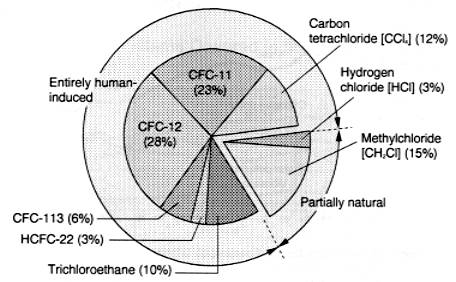
Source: Environment Agency
Acid rain
Acid rain is a term used to describe rain and snow that carry high levels of acidity. It is created when precipitation mixes with air pollutants such as sulphur oxides and nitrogen oxides. It is feared that acid rain will acidify lakes, marshes and rivers, doing harm to fish and other forms of wildlife. It is also feared that acid rain will acidify soil, exerting a negative influence on woodlands. It will also fall on our cultural heritage and inflict damage. According to the interim report of the third investigation on acid rain measures, a similar level of acid rain is recorded in Japan as in Europe, where it has been causing damage to forests, lakes and marshes. If acid rain continues to fall in Japan, it is possible that the negative impact of the rain will become apparent in the future .
Distribution of pH in Rain 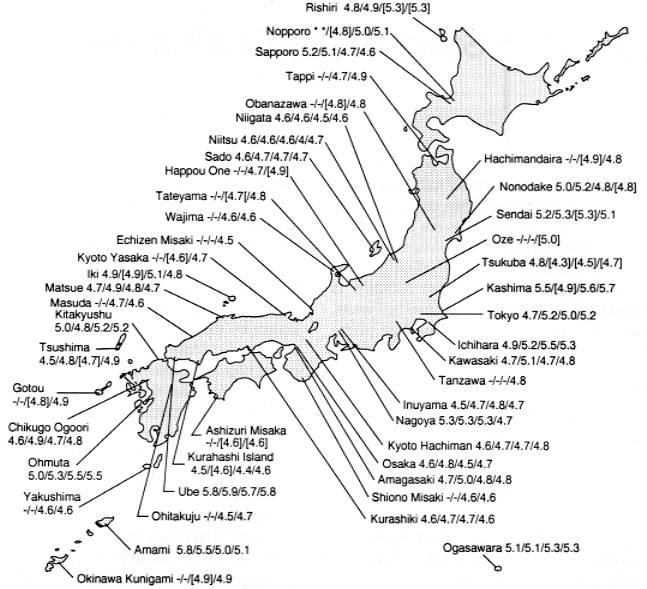
- -:
- Unmeasured
- []:
- Average figures dismissed due to unacceptable levels of impurity in the sample.
- **:
- Average figures dismissed due to the use of snow collecting device in winter.
- Notes:
- 1. The second survey figures are the average figures between 1989 and 1992.
- 2. In Sapporo, Niitsu, Nonodake and Tsukuba, the frequency of measurement differs between 1993 and after that year.
- 3. The measurement s in Tokyo in the second survey and surveys from 1993 were carried out at different locations.
- 4. The measurement site in Kurahashi island differs between 1993 and after that year.
Source: Environment Agency
State of air pollution caused by nitrogen oxides etc.
In Japan, the concentration of sulphur dioxide and carbon monoxide in the air has fallen within acceptable limits in recent years. However, when it comes to nitrogen dioxides and suspended particulate matter, the achievement rates of the Environmental Quality Standards have been low, particularly in metropolitan areas. Regarding toxic chemical substances such as dioxin which is formed unintentionally and released into the air, measures are being taken based on the Air Pollution Control Law that was revised in 1996.
Issues related to our living environment such as noise, vibration, offensive odor, heat islands and artificial light pollution
Problems such as noise, vibration and offensive odors are intimately connected with the immediate senses of the general public. Solving these problems is an important task in order to protect our immediate living environment. Although the number of complaints made for each category of problem is decreasing every year, they still hold a major share in the total number of pollution-related complaints made to the authorities. Furthermore, the causes for this category of complaint are becoming more diversified. Highest among the list of pollution-related complaints are those regarding noise pollution. In particular, complaints against factories and business complexes are increasing. As for offensive odors, the number of complaints against service industries and households in urban and residential areas is increasing.
In addition, in mega-cities, such as the Tokyo metropolitan area, a phenomenon called the "heat island" has become an issue. Heat islands are caused by the predominance of asphalt ground cover, which prevents the drop in night time temperatures that would otherwise be caused by water evaporation. The problem of excessive artificial light eliminates the possibility of observing stars in the night sky, and it might also have a negative effect on ecosystems.
Trends in Number of Complaints in Typical 7 Cases of Pollution Categories 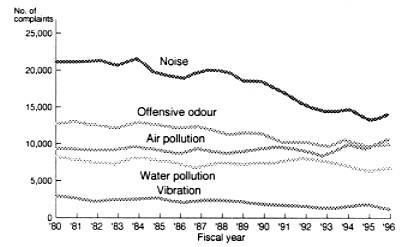
- Source:
- Environmental Dispute Coordination Commission
In 1996, 229 cases of soil contamination and 23 cases of land subsidence related complaints were recorded, however, these are omitted in this chart.
State of water pollution
The Environmental Quality Standards achievement rate regarding river water pollution has been improving since 1994 when the rate dipped due to water shortages. However, the achievement rates in closed aquatic environments such as lakes, marshes and inner bays are still low. To improve water quality in such closed environments, it is necessary to reduce pollutants released into the area. To realize this, Tokyo Bay, Ise Bay and the Seto Inland Sea have been designated as special areas where the achievement of Environmental Quality Standards is difficult given current effluent emission levels. The fourth Areawide Water Pollutant Emission Regulation is being carried out in these areas. The restrictions are adhered to more diligently in the sea areas than they are in the river, lake and marsh areas. It is judged that a certain degree of improvement has been seen.
Regarding industrial effluent in Japan, measures such as the reinforcement of effluent restrictions have been effective. However, regarding household effluent, measures still lag far behind expectations. There are still insufficient numbers of sewage systems and combined sewage treatment facilities. In particular, in lakes and marshes whose watersheds have been urbanized, the rate of installation of sewage systems has not caught up with the increases in population. As a result, the percentage of household effluent in the whole national effluent load is becoming larger.
Trends in the Achievement Rate of Environmental Quality Standards (BOD or COD) 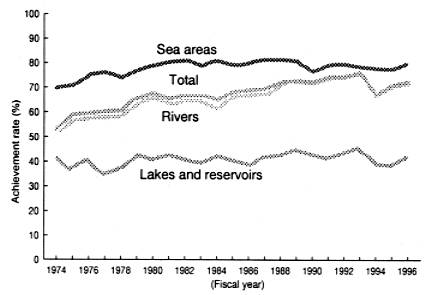
Source: Environment Agency
Items Covered in the Environmental Quality Standards
to Assess Organic Contamination of Water
| COD | BOD | pH | SS | DO | Number of Coliform group | Total Nitrogen | Total Phosphorus | N-Hexane Extracts | |
|---|---|---|---|---|---|---|---|---|---|
| Rivers | - | - | - | - | |||||
| Lakes and reservoirs | - | - | |||||||
| Coastal waters | - | - |
COD:Chemical oxygen demand, BOD:Biological oxygen demand, pH:Hydrogen ion exponent, SS:Suspended solids, DO:Dissolved oxygen
Source: Environment Agency
Maintenance and recovery of a healthily functioning water cycle
Water is a renewable resource that can be used again and again as it circulates naturally. In order to conserve aquatic environments it is an important task to maintain and recover a sound water cycle. To secure a healthy water cycle, in addition to existing water quality regulations, further measures such as the maintenance of forests and paddy fields, the utilization of rain water and the installation of water absorbent/permeable facilities, and an increase in green spaces, need to be adopted on a comprehensive basis both in the countryside and in cities.
Conservation of the marine environment
The oceans are often the final destination of pollutants emitted on land, and oceanic pollution is recorded around the world. In 1997, 713 cases of marine pollution around Japan were reported by the Maritime Safety Agency. This was 41 cases less compared with the figure in 1996. Of these 713 cases, 405 involved oil pollution which accounts for a high percentage. 254 were caused by other pollutants such as disposed waste, toxic liquids and industrial discharge. 54 were caused by red tides.
Trends in Number of Confirmed Cases of Marine Pollution 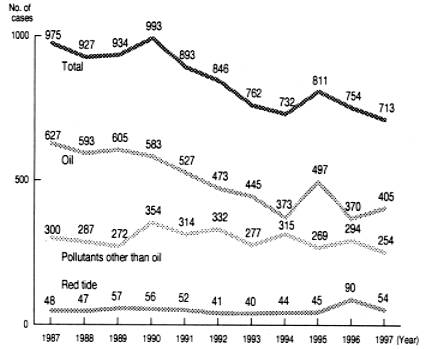
Source: Marine Safety Agency
Soil Contamination and land subsidence
Soil contamination is a long-term problem: contaminants accumulate and have a long lasting impact on agricultural products and underground water etc. It is very difficult to improve contaminated soil or return it to its original state. Regarding soil on agricultural land, 7,140 ha of land have been identified as contaminated, of which 5,410 ha have been treated. Regarding soil contamination in business and residential areas, there have been frequent instances where heavy metals in soil have been detected as a result of soil investigations carried out when reusing lands formerly occupied by factories.
Regarding land subsidence, restrictions on underground water pumping have improved the overall situation. However, in 1996, areas where more than 4 cm per year of land subsidence was reported increased substantially from less than 0.5 square kilometers to 22 square kilometers. It is feared that the deterioration of soil's water retention capacity due to deforestation will worsen land subsidence by reducing water supply to underground reservoirs.
Number of Reported Soil Contamination Cases in Business and Residential Areas 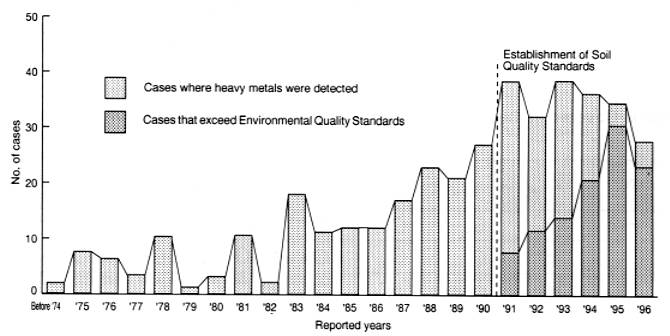
Note: Although this survey began in 1975, cases reported before that year are also included.
Source: Environment Agency
State of Land Subsidence in Japan (1996) 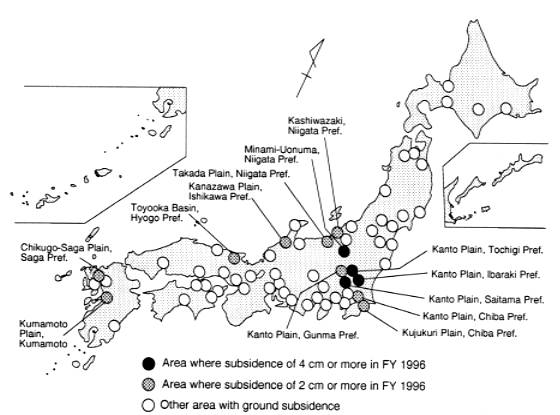
Source: Environment Agency
Recycling containers and packaging etc.
The reduction and recycling of waste have become urgent problems. Based on the Law for Promotion of Sorted Collection and Recycling of Containers and Packaging, separate collection and reuse of aluminium containers and packing, glass containers, paper containers for drinks and polyethylene terephthalate (PET) containers has been initiated. Moreover, recycling rates for steel and aluminum cans have been rising.
Trends in the Garbage Recycling Rate 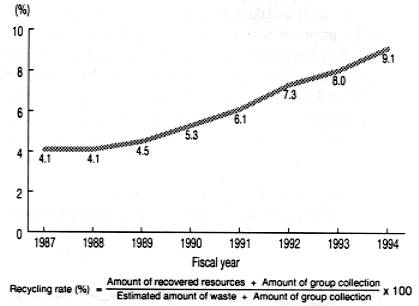
Source: Ministry of Health and Welfare
State of the natural environment
Japan has vegetation cover on 92.5% of the total land area, of which 67.1% is covered with forests. This percentage is high compared with other countries, however, natural environments are increasingly confined to limited areas. Natural vegetation cover accounts for only 19.1% of the country and 58.8% of it can be found in Hokkaido. In the Kinki, Chugoku, Shikoku and Kyushu regions, naturally forested areas are very small, and are largely located in the higher regions of mountains, and peninsulas and islands.
Classification of vegetation zones in Japan (by region) 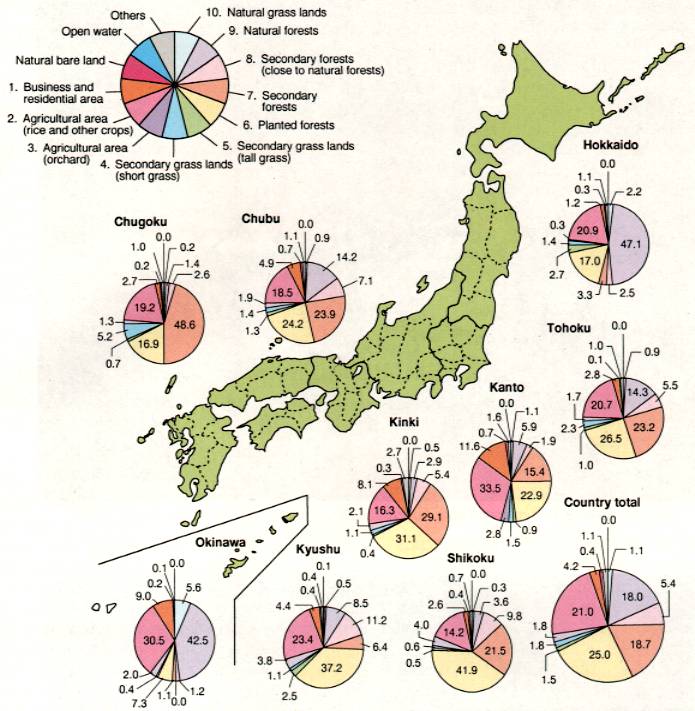
Source: The Fourth National Survey on the Natural Environment (Vegetation survey)
Moreover, a recent investigation regarding lake, marsh, river and ocean areas revealed that these wetlands are increasingly becoming artificial. Some of these natural environments play important roles in ecosystems. Artificial manipulation of the natural environment is irreversible, and therefore must be undertaken with great care.
State of the natural environment overseas
Forest covers one quarter of the earth's land surface, and plays important roles in absorbing CO2, regulating thermal radiation and adjusting the water balance etc. Forests also fulfill the important function of conserving biological diversity. The rapid disappearance of tropical forest in recent years not only means the exhaustion of forest resources but also a decreasing number of species. Moreover, it is feared that large quantities of CO2 emission due to deforestation will accelerate global warming.
Rate of Deforestation by Country (1980-1990) 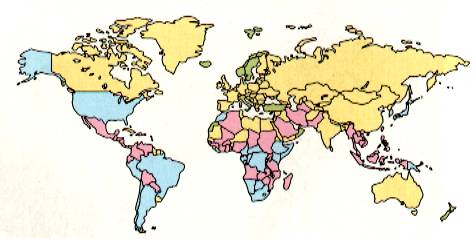
Annual deforestation rates
| Stabilized or increased | |
| Less than 0.6 % | |
| 0.6% or above | |
| No data |
Source: World Resources and Environment '90-'97
Desertification has been progressing due to both climatic and human-related factors. In the Sahel area in Africa, over-grazing and short-cycle slash and burn agriculture have been accelerating desertification. According to the United Nations Environment Programme (UNEP), more than 6.1 billion ha, nearly 40% of the world's land area is arid. One fifth of the world's population lives in these arid areas. Of the arid areas, about 0.9 billion ha are classified as "desert" and desertification caused by human activities is advancing in the remaining 5.2 billion ha area.
State of wildlife in Japan
Japan, due to its varied geography and topography has a variety of ecosystems in climates ranging from the sub-tropical to the sub-Arctic. Regarding animal species, around 1,214 species of vertebrates and 35,207 species of invertebrates have been recorded. As for plant species, 7,087 species of vascular plants, 5,500 species of algae, 1,800 species of mosses, 1,000 species of lichens and 16,500 species of fungi have been recorded. Although these numbers are relatively small compared with countries that have tropical forests with a large number of wildlife species, compared with other developed nations, especially the European nations, they are of a higher standard. The Environment Agency is establishing wildlife protection areas in which it is necessary to protect and breed wildlife. At the same time, regarding agricultural damage inflicted by wildlife such as deer, the Environment Agency is promoting measures to prevent damage and manage wildlife.
The expansion of social and economic activities by human beings has been destroying wildlife habitats, reducing the numbers of wildlife, and driving some wildlife species to extinction. The Government has carried out investigations on wildlife species that need urgent protection, and has published the "Red Data Book" cataloguing endangered species. In 1997, categories in the Red Data Book were revised and species included in existing categories are being transferred to the new categories. According to the Red Data Book, approximately 7% of mammals, 8% of birds, 19% of rupters, 22% of amphibians and 11% of freshwater/brackish-water fish are threatened with extinction.
Endocrine disrupting chemicals (environmental hormone)
In the 1996 environmental investigation on chemical substances in fish bodies, 4 substances out of 7 targeted for investigation were discovered. These substances included possible endocrine disrupters. Endocrine disrupters enter human cells, bind to hormone receptors, and release faulty signals to genes. It is suspected that this may lead to growth, reproductive and other health problems such as reduction in sperm count, and an increase in breast and ovarian cancer. Scientific research on endocrine disrupters and their impacts should be carried out urgently, since these substances affect the human body with a different mechanism from carcinogens which have been used to determine the safety standards applied to chemical substances.
Conserving biodiversity
Today's extinctions are caused by human activities rather than occurring as a result of natural processes, and the rate of extinctions is the highest since the Earth's history began. Therefore, extinction is regarded as a global environmental problem, and international efforts are made, using international agreements such as the Convention on International Trade in Endangered Species of Wild Fauna and Flora and the Ramsar Convention. In addition, in order to comprehensively conserve biodiversity on the Earth, the Convention on Biological Diversity has been concluded. Given this, Japan has formulated the National Strategy of Japan on Biological Diversity. In this strategy, with understanding of the present state of biodiversity, long-term goals are laid down in order to realize the conservation of biodiversity and its sustainable use.
Numbers of Taxa of Fauna, Flora and Fungi, and Status of Threatened Taxa in Japan (As of March 1998)
No. of taxa on the new categories
| Classification | No. of taxa | Extinct | Extinct in the wild | Threatened | Near threatened | Data deficient | No. of threatened taxa | |||
|---|---|---|---|---|---|---|---|---|---|---|
| Threatened I | Threatened II | |||||||||
| Threatened 1A : 1B | ||||||||||
| Animals | Reptiles | 97 | 0 | 0 | 7 | 11 | 9 | 1 | 18 | |
| 2 : 5 | ||||||||||
| Amphibians | 64 | 0 | 0 | 5 | 9 | 5 | 0 | 14 | ||
| 1 : 4 | ||||||||||
| Plants | Vascular plants | 7,087 | 17 | 12 | 881 | 518 | 108 | 365 | 1,399 | |
| 471 : 410 | ||||||||||
| Bryophytes | Abt. 1,800 | 0 | 0 | 110 | 70 | 4 | 54 | 180 | ||
| Algae | Abt. 5,500 | 5 | 2 | 34 | 6 | 24 | 0 | 40 | ||
| Lichen | Abt. 1,000 | 3 | 0 | 22 | 23 | 17 | 17 | 45 | ||
| Fungi | Abt. 16,500 | 28 | 1 | 51 | 11 | 0 | 0 | 62 | ||
No. of taxa based on the old categories
| Classification | No. of taxa | Extinct | Threatened | Rare | No. of threatened taxa | |||
|---|---|---|---|---|---|---|---|---|
| Endangered | Vulnerable | |||||||
| Animals (excluding amphibians and reptiles) | Mammals | 188 | 5 | 3 | 11 | 36 | 14 | |
| Birds | 665 | 13 | 27 | 27 | 65 | 54 | ||
| Brackish/freshwater fish | 200 | 2 | 16 | 6 | 17 | 22 | ||
| Insects | 30,146 | 2 | 23 | 15 | 166 | 38 | ||
| Brackish/freshwater, decapoda | 197 | 0 | 0 | 7 | 45 | 7 | ||
| Land/freshwater mollusca | 824 | 0 | 34 | 39 | 54 | 73 | ||
| Other animals | 4,040 | 0 | 4 | 3 | 11 | 7 | ||
| total | ||||||||
| 1,973 | ||||||||
- (1)
- The numbers of animal taxa (including sub-species) are based on "A Check List of Japanese Species of Wildlife" published in 1993 and 1995, edited by the Environment Agency
- (2)
- The numbers of vascular plant taxa (including sub-species) are based by the Japanese Society of Plant Taxonomisto.
- (3)
- Species numbers for algae, bryophytes, lichens and fungi (including sub-species) are from surveys carried out by the Environment Agency.
- (4)
- State of threatened taxa (including sub-species) is based on the "Endangered Wildlife Species of Japan" published in 1991 by the Environment Agency, except for the information on amphibians and reptiles which is based on data in 1997.
- (5)
- State of endangered plants is based on the Environment Agency's data compiled in 1997.
Utilization of nature parks and hot springs etc.
In recent years, as people's environmental awareness rises and, at the same time, as immediate natural areas disappear from the urban environment, there is an increasing need on the part of the general public to interact with nature. In 1996, 985.07 million people visited nature parks in Japan.